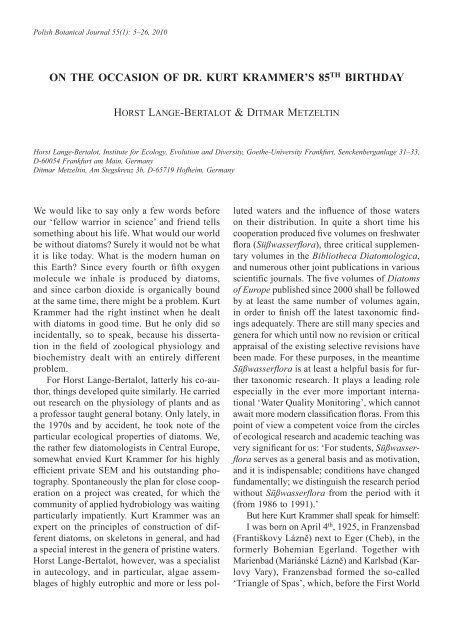Pbj551_s001-26.pdf
Pbj551_s001-26.pdf
Pbj551_s001-26.pdf
Create successful ePaper yourself
Turn your PDF publications into a flip-book with our unique Google optimized e-Paper software.
Polish Botanical Journal 55(1): 5–26, 2010<br />
ON THE OCCASION OF DR. KURT KRAMMER’S 85 TH BIRTHDAY<br />
HORST LANGE-BERTALOT & DITMAR METZELTIN<br />
Horst Lange-Bertalot, Institute for Ecology, Evolution and Diversity, Goethe-University Frankfurt, Senckenberganlage 31–33,<br />
D-60054 Frankfurt am Main, Germany<br />
Ditmar Metzeltin, Am Stegskreuz 3b, D-65719 Hofheim, Germany<br />
We would like to say only a few words before<br />
our ‘fellow warrior in science’ and friend tells<br />
something about his life. What would our world<br />
be without diatoms? Surely it would not be what<br />
it is like today. What is the modern human on<br />
this Earth? Since every fourth or fi fth oxygen<br />
molecule we inhale is produced by diatoms,<br />
and since carbon dioxide is organically bound<br />
at the same time, there might be a problem. Kurt<br />
Krammer had the right instinct when he dealt<br />
with diatoms in good time. But he only did so<br />
incidentally, so to speak, because his dissertation<br />
in the fi eld of zoological physiology and<br />
biochemistry dealt with an entirely different<br />
problem.<br />
For Horst Lange-Bertalot, latterly his co-author,<br />
things developed quite similarly. He carried<br />
out research on the physiology of plants and as<br />
a professor taught general botany. Only lately, in<br />
the 1970s and by accident, he took note of the<br />
particular ecological properties of diatoms. We,<br />
the rather few diatomologists in Central Europe,<br />
somewhat envied Kurt Krammer for his highly<br />
effi cient private SEM and his outstanding photography.<br />
Spontaneously the plan for close cooperation<br />
on a project was created, for which the<br />
community of applied hydrobiology was waiting<br />
particularly impatiently. Kurt Krammer was an<br />
expert on the principles of construction of different<br />
diatoms, on skeletons in general, and had<br />
a special interest in the genera of pristine waters.<br />
Horst Lange-Bertalot, however, was a specialist<br />
in autecology, and in particular, algae assemblages<br />
of highly eutrophic and more or less pol-<br />
luted waters and the infl uence of those waters<br />
on their distribution. In quite a short time his<br />
cooperation produced fi ve volumes on freshwater<br />
fl ora (Süßwasserfl ora), three critical supplementary<br />
volumes in the Bibliotheca Diatomologica,<br />
and numerous other joint publications in various<br />
scientifi c journals. The fi ve volumes of Diatoms<br />
of Europe published since 2000 shall be followed<br />
by at least the same number of volumes again,<br />
in order to fi nish off the latest taxonomic fi ndings<br />
adequately. There are still many species and<br />
genera for which until now no revision or critical<br />
appraisal of the existing selective revisions have<br />
been made. For these purposes, in the meantime<br />
Süßwasserfl ora is at least a helpful basis for further<br />
taxonomic research. It plays a leading role<br />
especially in the ever more important international<br />
‘Water Quality Monitoring’, which cannot<br />
await more modern classifi cation fl oras. From this<br />
point of view a competent voice from the circles<br />
of ecological research and academic teaching was<br />
very signifi cant for us: ‘For students, Süßwasserfl<br />
o r a serves as a general basis and as motivation,<br />
and it is indispensable; conditions have changed<br />
fundamentally; we distinguish the research period<br />
without Süßwasserfl ora from the period with it<br />
(from 1986 to 1991).’<br />
But here Kurt Krammer shall speak for himself:<br />
I was born on April 4 th , 1925, in Franzensbad<br />
(Františkovy Lázně) next to Eger (Cheb), in the<br />
formerly Bohemian Egerland. Together with<br />
Marienbad (Mariánské Lázně) and Karlsbad (Karlovy<br />
Vary), Franzensbad formed the so-called<br />
‘Triangle of Spas’, which, before the First World

















